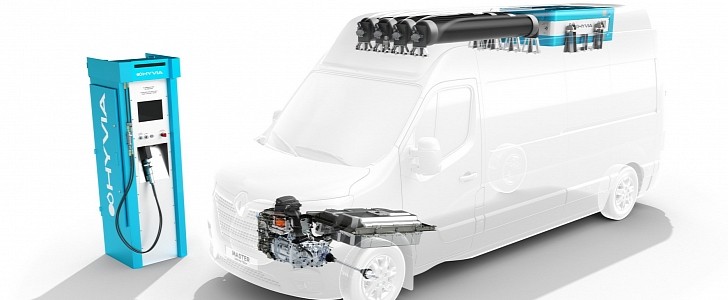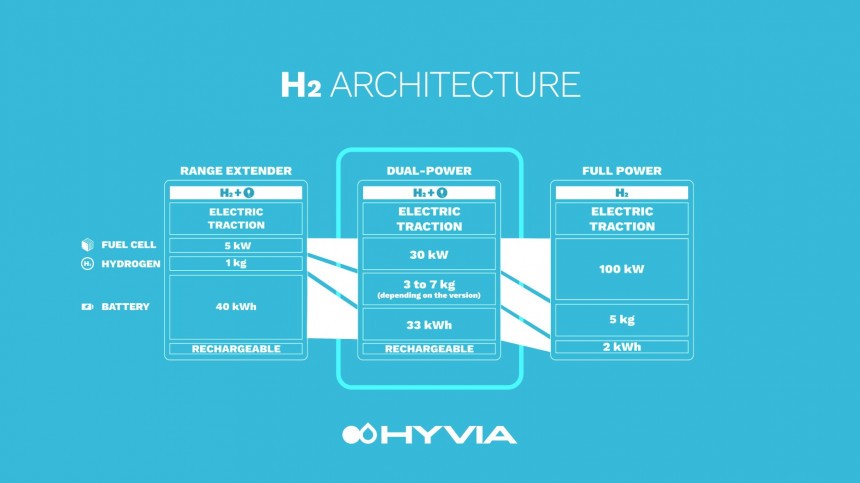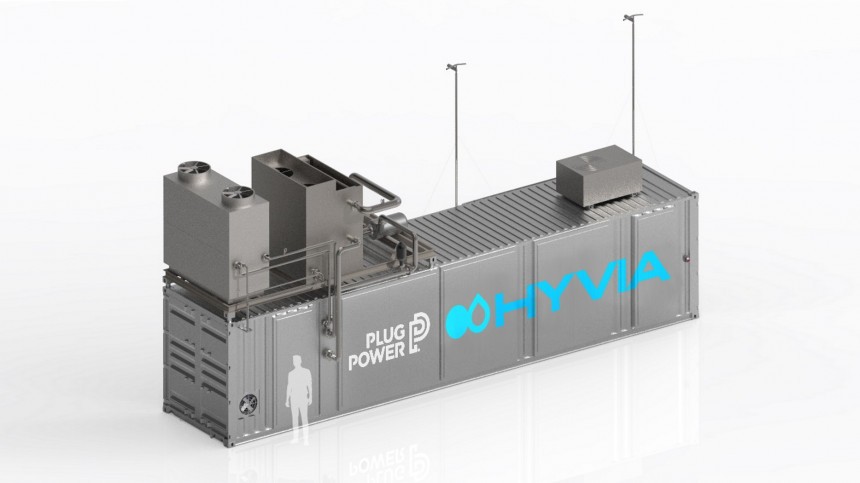Renault announced in July that it would invest in hydrogen and fuel cells with HYVIA. The focus of this joint venture with Plug Power was on commercial vehicles, where hydrogen makes more sense than current batteries. On October 14, HYVIA finally presented its prototypes: a van and a hydrogen station. The latter is what deserves more attention.
It is not an issue with the Master Van H2-TECH prototype. On the contrary: the van has a range of up to 500 kilometers (311 miles), and it can carry 12 cubic meters (423.8 cubic feet) of cargo thanks to a 33-kWh battery pack and a 30-kW fuel cell. That makes it what HYVIA calls a dual power vehicle, with a battery pack and the fuel cell providing energy for the van to move. The company also plans to offer two other vehicle options: FCEV range-extenders and FCEV full power.
The idea with all of them is that battery packs can provide the energy the vans will need to start moving. The difference is basically the size of the battery packs and the role they have. With FCEV range extenders, fuel cells’ only goal is to feed a 40-kWh battery pack, the only power reservoir for the electric motors. The dual power can have energy from either source.
The FCEV full power vehicles have a tiny 2-kWh battery pack just to get going, but most of its electricity comes from the fuel cels. This battery pack is not rechargeable like the other two. In other words, it works pretty much like the e-POWER system from Nissan, except that it uses fuel cells to produce electricity. Nissan has a 1.2-liter, three-cylinder engine as a generator.
Apart from being rechargeable, the video below shows that the Master’s battery pack is also fed by the 30-kW fuel cells. They generate electricity from the 6 kilograms of hydrogen stored in four tanks at 700 bar (10,152.6 psi). As math may have already told you, each tank stores 1.5 kg of hydrogen.
Despite being developed by Renault and Plug Power, the tanks and the fuel cell are housed on the roof of the Master Van H2-TECH, which gives us a bad impression that Renault just adapted a vehicle it already had to run on hydrogen. It may make sense from a business perspective – by cutting investments in development – but the message it sends is that the company’s hopes are in other solutions.
Despite that, it is the Hydrogen Refueling Station that looks like genius. HYVIA will lease it, sell it, or rent it to fleet owners to place them anywhere they want. These stations will use electrolysis to convert water into hydrogen, theoretically with renewable sources of energy. It is not clear how HYVIA expects to ensure these green electricity sources for its stations.
The images HYVIA released show that these stations will be mobile. Their entire structures will fit in a large container that can be transported anywhere. The hydrogen pumps are probably easy to install. This kind of flexibility will help HYVIA easily create hydrogen infrastructure. We do not doubt that fuel station owners may consider buying one of these stations to sell hydrogen in the near future, allowing FCEV owners to refuel more readily.
BEV advocates will probably look at all this and say that all the energy spent in making hydrogen, compressing it, and delivering it to the high-pressure tanks in FCEVs shows why it makes no sense to bet on fuel cells.
The issue with that sort of reasoning is that the other options would be to have a massive battery pack, lose load capacity, or stick with combustion engines, most certainly with diesel.
In the first case, you would need more trips to carry the same amount of goods, which can curb the efficiency advantage. In the second, we’d just have to keep things as they are. For people that argue the goal is to have clean transportation, going against FCEVs sounds like pure hypocrisy.
The idea with all of them is that battery packs can provide the energy the vans will need to start moving. The difference is basically the size of the battery packs and the role they have. With FCEV range extenders, fuel cells’ only goal is to feed a 40-kWh battery pack, the only power reservoir for the electric motors. The dual power can have energy from either source.
The FCEV full power vehicles have a tiny 2-kWh battery pack just to get going, but most of its electricity comes from the fuel cels. This battery pack is not rechargeable like the other two. In other words, it works pretty much like the e-POWER system from Nissan, except that it uses fuel cells to produce electricity. Nissan has a 1.2-liter, three-cylinder engine as a generator.
Despite being developed by Renault and Plug Power, the tanks and the fuel cell are housed on the roof of the Master Van H2-TECH, which gives us a bad impression that Renault just adapted a vehicle it already had to run on hydrogen. It may make sense from a business perspective – by cutting investments in development – but the message it sends is that the company’s hopes are in other solutions.
Despite that, it is the Hydrogen Refueling Station that looks like genius. HYVIA will lease it, sell it, or rent it to fleet owners to place them anywhere they want. These stations will use electrolysis to convert water into hydrogen, theoretically with renewable sources of energy. It is not clear how HYVIA expects to ensure these green electricity sources for its stations.
BEV advocates will probably look at all this and say that all the energy spent in making hydrogen, compressing it, and delivering it to the high-pressure tanks in FCEVs shows why it makes no sense to bet on fuel cells.
The issue with that sort of reasoning is that the other options would be to have a massive battery pack, lose load capacity, or stick with combustion engines, most certainly with diesel.
In the first case, you would need more trips to carry the same amount of goods, which can curb the efficiency advantage. In the second, we’d just have to keep things as they are. For people that argue the goal is to have clean transportation, going against FCEVs sounds like pure hypocrisy.
















